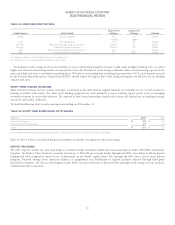American Express 2014 Annual Report Download - page 51
Download and view the complete annual report
Please find page 51 of the 2014 American Express annual report below. You can navigate through the pages in the report by either clicking on the pages listed below, or by using the keyword search tool below to find specific information within the annual report.AMERICAN EXPRESS COMPANY
2014 FINANCIAL REVIEW
As defined in the ERM policy, we follow the “three lines of defense” approach to risk management. The first line of defense comprises
functions and management committees directly initiating risk taking. Business unit presidents, our Chief Credit Officer, Chief Operational
Risk Officer, Chief Market Risk Officer and Functional Risk Officer are part of the first line of defense.
The second line comprises independent functions overseeing risk taking activities of the first line. The Global Risk Oversight Officer and
Market Risk Oversight Officer, the Chief Compliance & Ethics Officer, the Corporate Comptroller and certain control groups, both at the
enterprise level and within regulated entities, are part of the second line of defense. The global risk oversight teams oversee the policies,
strategies, frameworks, processes and capabilities deployed by the first line teams and act as a check to the first line of defense in managing
risks.
Our Internal Audit Group constitutes the third line of defense, and provides independent assessments and effective challenge of the first
and second lines of defense.
In addition, the Asset-Liability Committee (ALCO), chaired by the Company’s Chief Financial Officer, is responsible for managing
market, liquidity, asset/liability risk and capital.
CREDIT RISK MANAGEMENT PROCESS
Credit risk is defined as loss due to obligor or counterparty default or changes in the credit quality of a security. Our credit risks are divided
into two broad categories: individual and institutional. Each has distinct risk management capabilities, strategies, and tools. Business units
that create individual or institutional credit risk exposures of significant importance are supported by dedicated risk management teams,
each led by a Chief Credit Officer. To preserve independence, Chief Credit Officers for all business units report to our Chief Credit Officer,
who in turn reports directly to our Chief Risk Officer.
INDIVIDUAL CREDIT RISK
Individual credit risk arises principally from consumer and small business charge cards, credit cards, lines of credit, and loans. These
portfolios consist of millions of customers across multiple geographies, industries and levels of net worth. We benefit from the high-quality
profile of our customers, which is driven by our brand, premium customer servicing, product features and risk management capabilities,
which span underwriting, customer management and collections. Externally, the risk in these portfolios is correlated to broad economic
trends, such as unemployment rates and GDP growth, which can affect customer liquidity.
The business unit leaders and their Chief Credit Officers take the lead in managing the individual credit risk process. These Chief Credit
Officers are guided by the Individual Credit Risk Committee, which is responsible for implementation and enforcement of the Individual
Credit Risk Management Policy. This policy is further supported by subordinate policies and operating manuals covering decision logic and
processes of credit extension, including prospecting, new account approvals, point-of-sale authorizations, credit line management and
collections. The subordinate risk policies and operating manuals are designed to ensure consistent application of risk management principles
and standardized reporting of asset quality and loss recognition.
Individual credit risk management is supported by sophisticated proprietary scoring and decision-making models that use the most up-
to-date information on prospects and customers, such as spending and payment history and data feeds from credit bureaus. Additional data,
such as commercial variables, are integrated to further mitigate small business risk. We have developed data-driven economic decision logic
for customer interactions to better serve our customers.
INSTITUTIONAL CREDIT RISK
Institutional credit risk arises principally within our Global Corporate Payments, Global Merchant Services, GNS, Prepaid Services, and
Foreign Exchange Services businesses, as well as investment and liquidity management activities. Unlike individual credit risk, institutional
credit risk is characterized by a lower loss frequency but higher severity. It is affected both by general economic conditions and by client-
specific events. The absence of large losses in any given year or over several years is not necessarily representative of the level of risk of
institutional portfolios, given the infrequency of loss events in such portfolios.
51
























